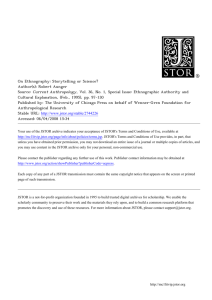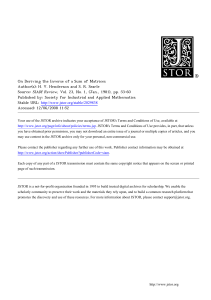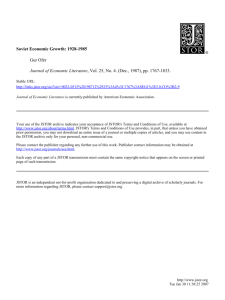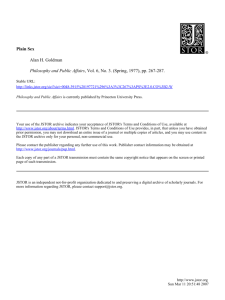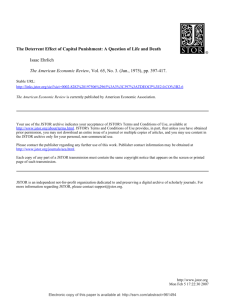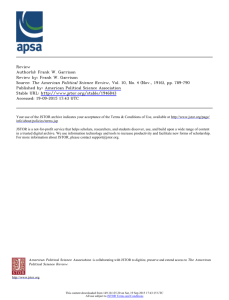America, Russia, and the Cold War, 1945
advertisement
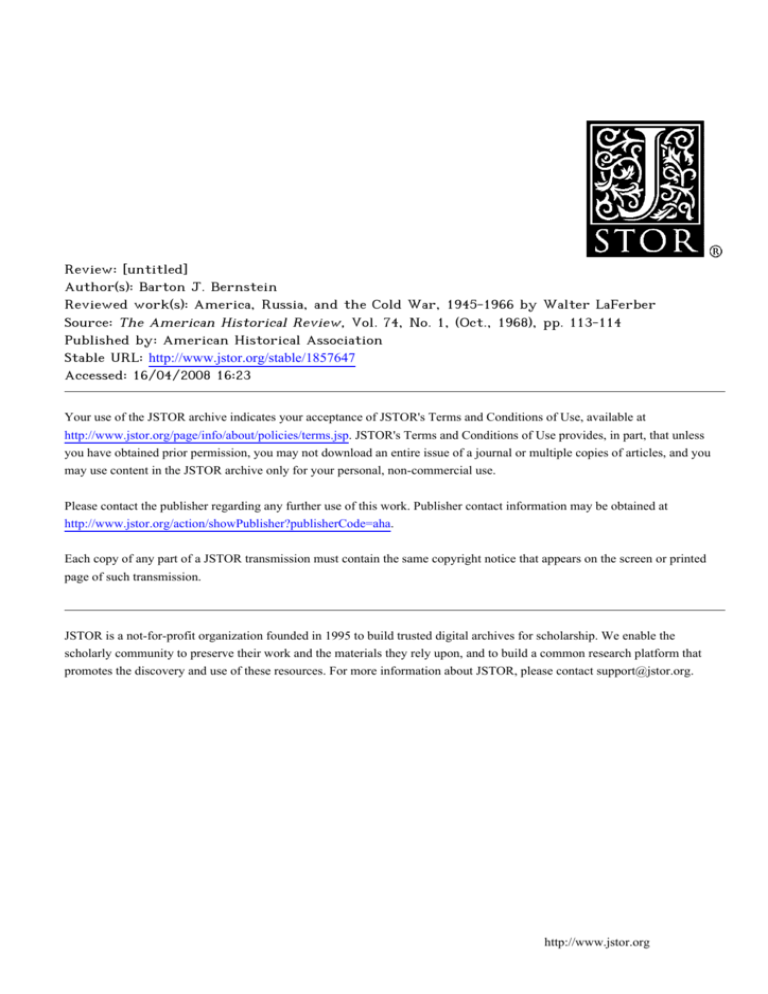
Review: [untitled] Author(s): Barton J. Bernstein Reviewed work(s): America, Russia, and the Cold War, 1945-1966 by Walter LaFerber Source: The American Historical Review, Vol. 74, No. 1, (Oct., 1968), pp. 113-114 Published by: American Historical Association Stable URL: http://www.jstor.org/stable/1857647 Accessed: 16/04/2008 16:23 Your use of the JSTOR archive indicates your acceptance of JSTOR's Terms and Conditions of Use, available at http://www.jstor.org/page/info/about/policies/terms.jsp. JSTOR's Terms and Conditions of Use provides, in part, that unless you have obtained prior permission, you may not download an entire issue of a journal or multiple copies of articles, and you may use content in the JSTOR archive only for your personal, non-commercial use. Please contact the publisher regarding any further use of this work. Publisher contact information may be obtained at http://www.jstor.org/action/showPublisher?publisherCode=aha. Each copy of any part of a JSTOR transmission must contain the same copyright notice that appears on the screen or printed page of such transmission. JSTOR is a not-for-profit organization founded in 1995 to build trusted digital archives for scholarship. We enable the scholarly community to preserve their work and the materials they rely upon, and to build a common research platform that promotes the discovery and use of these resources. For more information about JSTOR, please contact support@jstor.org. http://www.jstor.org General 113 prepared to counter a major thrust in the Far East. Collective security, he points out, worked in Europe so long as London and Paris were sufficiently agreed to underwrite the League's decisions. The peace machinery designed at Versailles was capable of settling minor disputes between major powers and major quarrels between minor states. Whether any possible choice of policies on the part of leading European statesmen could have nursed the League to the point where it could handle serious rifts between the most important states is unknowable. To Dexter's credit, he has in this sprightly narrative kept such idle speculation to a minimum. State University of New York, Buffalo SELIG ADLER AMERICA, RUSSIA, AND THE COLD WAR, 1945-1966. By Walter LaFeber. [America in Crisis.] (New York: John Wiley and Sons. 1967. Pp. xi, 295. Cloth $6.50, paper $2.95.) THE first book-length, scholarly analysis of the cold war from a "revisionist" perspective since D. F. Fleming's two-volume study in 1961, this book defines most of the issues likely to provoke debate in the next decade as scholars re-examine postwar American foreign policy. The rise of the cold war, argues LaFeber, was neither surprising nor remarkable; rather, the rapid decay of US-Soviet relations in 1945, visible in the uneasy wartime relationship, was rooted in preceding decades of American hostility to the Bolshevik state. Though he seems ambivalent about whether different US actions might have allayed Stalin's fears of capitalist encirclement, LaFeber argues that American ideology and action were chiefly responsible for the cold war. The dominant concern of American policy makers, he contends, was the need to establish an international economic system that would provide expanding markets for American surpluses and contribute to international peace and prosperity. There is ample evidence, both in the manuscript sources exploited by the author and in the Department of State Bulletin, of American efforts to reshape the world by imposing an "open door" beyond the United States' sphere of influence. American economic expansion, according to policy makers, required order and stability and entailed opposition to revolution, which was translated easily into anti-Communism. The United States, the author emphasizes, tried to use its overwhelming economic power to compel Russia to accept a multilateral economy and to open the satellites to American economic penetration. The cold war, he concludes, emerged directly from this conflict between the world-wide ambitions of American diplomacy and Stalin's determination to maintain control of Eastern Europe, which was vital to the Soviet economy and security. LaFeber denies that Russia was militantly expansionist in the postwar years and emphasizes Stalin's generally conservative policies, but he unfortunately never marshals enough of the available evidence to convince skeptical readers. Perhaps because he focuses on the American "open door" ideology, he also overlooks the Roosevelt government's reluctant agreement in late 1944 and early 1945 to the division of Eastern Europe into spheres of influence. Rather than the Truman administration's struggling simply to roll back Communism in Eastern Europe, as LaFeber does argue, the government was in effect repudiating 114 Reviews of Books this earlier understanding. He concludes that after Hiroshima the administration increased its efforts and turned to the practice of atomic diplomacy. Upon establishing to his satisfaction the significance of the "open door" ideology, LaFeber seldom relies directly upon this interpretation in his discussion of foreign policy beyond 1948. (Indeed, he later deftly explains in other terms the anti-Communism of the liberal community, focusing upon Reinhold Niebuhr.) Many scholars will find that they can accept much of the later analysis without endorsing the earlier interpretation. Yet his arguments are not carelessly sandwiched together, as some critics may claim. Rather, he seems to believe that the earlier concern about the "open door" so influenced the shape of postwar history and the perceptions of policy makers that their original reasons for opposition to Communism were often obscured, and the United States government was often compelled by its anti-Communism to depart from the very multilateralism that policy makers had sought to establish. It is unfortunate that LaFeber does not clearly explain this, but, undoubtedly, that was part of the price of compressing into ninety thousand words an analysis of twenty-two years of foreign policy. The harsh limits of space, dictated by the general format of the series, also mean that many events are treated in fleeting fashion and that some important questions are overlooked. For example, how fluid was the situation in Eastern Europe between Hiroshima and the Truman Doctrine, and why did Russian policy harden in 1947? Was the American nuclear umbrella credible in 1947? How clearly did American policy makers in 1946 and 1947 understand the importance of the German question to Russia, and did they simply accede to Clay's decision to break the Potsdam Agreement on reparations? Did the missiles in Cuba really change the strategic balance, or did the administration actually respond to a threat to American credibility? Despite these limitations and some unfortunate errors, this volume is a judicious and impressive reassessment of the cold war. By defining so many of the issues, by boldly acknowledging the general continuity of postwar foreign policy, by skillfully integrating domestic and foreign policy, and particularly by concentrating upon the perils to the nation of Presidents conducting foreign policy largely independent of effective congressional restraint, LaFeber has produced a volume of contemporary relevance and scholarly importance. Stanford University BARTON J. BERNSTEIN THE NATO INTERNATIONAL STAFF/SECRETARIAT, 1952-1957: A STUDY IN INTERNATIONAL ADMINISTRATION. By Robert S. Jordan. (New York: Oxford University Press. 1967. Pp. x, 307. $9.60.) THIS is a detailed account and assessment of one selected aspect of international history during the middle years of the 1950's. It describes, using public records and interview materials, the problems confronted by the first Secretary-General of NATO, Lord Ismay, as he sought to build and administer a viable staff organization that, in turn, would render more effective the political and military instrument of the Atlantic community. The task was impossible since real authority lay with the member nations, but Lord Ismay did his best and left behind a record of administrative accomplishment that enhanced the organization's prestige and enabled it to function as well as could be expected.


